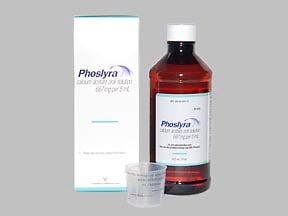
Phoslyra Coupons & Savings Card – Discount Prices from $158.10
My prescription
Edit
473ML of 667MG/5ML, Phoslyra (1 Bottle)
Select pharmacy

CVS
$160.87
COUPON PRICE
Walmart
$158.10
COUPON PRICE
Walgreens
$169.09
COUPON PRICEPhoslyra savings card
Show this card to your pharmacist
Walmart
$158.10
BIN
ID
PCN
GRP
019876
LHA2F775C3
CHIPPO
LHX
Powered by
Related phosphate binders prescriptions
More prescriptions for kidney disease
Related phosphate binders prescriptions
More prescriptions for kidney disease
Price history for Phoslyra
1 Bottle, 473ML of 667MG/5ML
Average retail price for Phoslyra
Average SaveHealth price for Phoslyra
Our price history data is based on aggregated prescription data collected from participating pharmacies in America. Our prescription data updates daily to reflect the latest price changes. If you notice a missing data point, it means there wasn't sufficient data available to generate a monetary value for that date.
*Retail prices are based on pharmacy claims data, and may not be accurate when we don't have enough claims.
Phoslyra dosage forms
Dosage Quantity Price from Per unit 473ML of 667MG/5ML 1 Bottle $158.10 $158.10 473ML of 667MG/5ML 2 Bottles $333.74 $166.87 473ML of 667MG/5ML 3 Bottles $506.62 $168.87
| Dosage | Quantity | Price from | Per unit |
|---|---|---|---|
| 473ML of 667MG/5ML | 1 Bottle | $158.10 | $158.10 |
| 473ML of 667MG/5ML | 2 Bottles | $333.74 | $166.87 |
| 473ML of 667MG/5ML | 3 Bottles | $506.62 | $168.87 |
Phoslyra Warnings
This safety notice outlines essential warnings and contraindications associated with the use of this medication. It is crucial to understand these risks and speak with your healthcare provider if you have any questions or concerns.
Elevated Blood Calcium Levels (Hypercalcemia): The use of calcium acetate can increase calcium levels in your blood, potentially leading to hypercalcemia. Symptoms may include nausea, vomiting, constipation, or loss of appetite. In severe cases, it could result in dangerous heart rhythm disturbances or seizures. Be cautious if you are consuming calcium supplements, other calcium-containing medications (such as antacids), or calcium-rich foods.
Interaction with Digoxin: If you are taking digoxin (Lanoxin), be aware that elevated calcium levels from calcium acetate can heighten your risk of digoxin toxicity. This condition can result in symptoms such as nausea, changes in vision, headaches, confusion, and heart rhythm abnormalities.
Contraindications: Do not use this medication if you have high blood calcium levels (hypercalcemia), as it poses significant health risks. Always consult your healthcare provider if you suspect this condition applies to you.
In case of an overdose or an emergency, seek immediate medical attention to ensure prompt and appropriate care.
Phoslyra Side Effects
When using this medication, some individuals may experience stomach upset, which is usually mild. However, if this persists or worsens, you should inform your healthcare provider. Other common side effects include high calcium levels in the blood, nausea, and vomiting. These are often mild but should be monitored if they continue or become bothersome. In some cases, individuals may encounter more significant side effects such as stomach or abdominal pain, loss of appetite, nausea, vomiting, constipation, confusion, dry mouth, increased thirst, and frequent urination. If you experience any of these, contacting your healthcare provider is advised. Rarely, some users may develop very high calcium levels, leading to symptoms such as tiredness, muscle weakness, bone pain, confusion, or delirium. It is important to seek medical advice if these symptoms occur. A very serious allergic reaction to this medication is uncommon but can include rash, itching, swelling (particularly of the face, tongue, or throat), severe dizziness, and difficulty breathing. Immediate medical attention is necessary if these symptoms are observed. Always consult your healthcare provider if you notice any other unexpected effects.
Phoslyra Interactions
Calcium Acetate can interact with several medications and supplements, which could affect how well these drugs work or increase the risk of side effects. It is important to inform your healthcare provider about all medications and supplements you are taking, including those prescribed by your doctor and those available over-the-counter, as well as vitamins and herbal products.
Certain drugs, such as calcium channel blockers like Verapamil, calcium supplements, and antacids containing calcium, may interact with calcium acetate. Additionally, calcium acetate can reduce the absorption of specific medications, including bisphosphonates (like Alendronate), Phenytoin, quinolone antibiotics (such as Ciprofloxacin and Levofloxacin), strontium, thyroid medications (for example, Levothyroxine), and tetracycline antibiotics (such as doxycycline and Minocycline). To minimize these interactions, it is advised to space out the doses of these medications as far apart from calcium acetate as possible. Consult your doctor or pharmacist for guidance on how long to wait between doses and to establish a suitable dosing schedule.
Furthermore, using calcium acetate with other medications like Baloxavir Marboxil, Bictegravir, Digoxin, Dolutegravir, Eltrombopag, Elvitegravir, Erdafitinib, Ketoconazole, Raltegravir, and Sodium Polystyrene Sulfonate is generally not recommended. However, if your doctor prescribes both, they may adjust the dose or frequency.
In some cases, it might be necessary to take calcium acetate with drugs like Chlorothiazide, Chlortetracycline, Ciprofloxacin, Delafloxacin, Demeclocycline, Doxycycline, Enoxacin, Grepafloxacin, Levofloxacin, Levothyroxine, Lomefloxacin, Lymecycline, Methacycline, Minocycline, Norfloxacin, Omadacycline, Oxytetracycline, Pefloxacin, Potassium Phosphate, Rolitetracycline, Sarecycline, Sodium Phosphate, Sparfloxacin, Strontium Ranelate, Tetracycline, Ticlopidine, and Zalcitabine. If both are prescribed, your healthcare provider may modify the dosage or timing to ensure safe and effective treatment.
What is PHOSLYRA used for?
Phoslyra is used to control high phosphate levels in patients with chronic kidney disease who are on dialysis. It works by binding to phosphate in the diet so it can be eliminated from the body, helping to prevent complications associated with high phosphate levels.
Was phoslyra discontinued?
Phoslyra has not been discontinued. It is still available as a treatment option for patients who require it.
What is the indication of Phoslyra?
Phoslyra is indicated for the control of serum phosphorus levels in patients with end-stage renal disease (ESRD) who are on dialysis.
